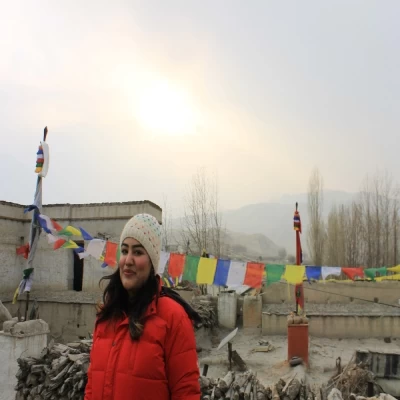What is the Uniqueness of Island Peak?
Island Peak, nestled strategically in Nepal's Everest region, stands out for its unique climbing route and spectacular panoramic views. This trek offers adventurers a close-up encounter with Everest, Lhotse, Nuptse, and other majestic peaks, making it a must-do for those seeking awe-inspiring Himalayan experiences.
The trek to Island Peak is not just about scaling heights but also about immersing oneself in the legendary environment of Everest Base Camp. This proximity enhances the adventure, combining the thrill of climbing with the allure of exploring Nepal's highest peaks. Embarking on the Island Peak trek allows you to trace the footsteps of mountaineering legends like Tenzing Norgay and Edmund Hillary, while experiencing the beauty of the Himalayas up close. Whether you're preparing for more challenging summits or simply seeking an unforgettable adventure in Nepal, Island Peak promises a fulfilling journey amidst breathtaking mountain scenery. Discover the allure of Island Peak for yourself and embark on a Himalayan adventure that combines thrilling climbs with panoramic mountain vistas, creating memories that will last a lifetime.
How Difficult is the Trek?
The Island Peak trek is categorized as a moderately difficult adventure, ideal for those with a good level of physical fitness and some prior trekking experience. The real challenge begins upon reaching Island Peak Base Camp, where the trail transitions into rocky, icy, and snowy paths that demand technical climbing skills. This trek serves as a perfect introduction to mountain climbing, though practicing technical skills beforehand is recommended.
Depending on your itinerary, the Island Peak journey typically spans 14 to 19 days. The actual climbing portion comprises just 2 days, with around 13-14 hours dedicated to summit day. Daily hikes to the base camp require 4-5 hours of trekking.Challenges along the route include crossing glaciers, rivers, rough terrain, and mountain passes. While prior climbing experience is beneficial, the expedition team provides necessary climbing instructions and guidance for overcoming obstacles.Weather conditions significantly impact the trek's difficulty, underscoring the importance of choosing the right season for climbing. Adequate preparation and selecting optimal trekking periods help ensure a safer and more enjoyable Island Peak adventure.
Discover the thrill of the Island Peak trek, an exhilarating Himalayan journey combining technical climbs with breathtaking landscapes. Whether you're a seasoned climber or embarking on your first mountain expedition, Island Peak promises an unforgettable experience amidst Nepal's stunning natural beauty.
Best time to trek
The optimal times to climb Island Peak are during spring (March to early June) and autumn (September to November). These seasons offer ideal weather conditions and maximize the enjoyment of the trekking journey, providing trekkers with stunning panoramic views and comfortable temperatures. Spring and autumn are favored for Island Peak expeditions due to stable weather patterns, clear skies, and manageable temperatures, making it easier to navigate the challenging terrain and appreciate the Himalayan scenery. These periods also coincide with the peak trekking season in Nepal, ensuring that adventurers can make the most of their experience without weather-related disruptions. Embarking on an Island Peak trek during spring or autumn allows climbers to witness the beauty of Everest, Lhotse, Nuptse, and other iconic peaks in their full glory, creating unforgettable memories amidst Nepal's breathtaking landscapes. Plan your adventure wisely to make the most of these optimal climbing seasons and ensure a rewarding Himalayan experience.
Island Peak Climb in Spring season:
The period from March to early June is widely regarded as the best time for trekking and climbing Island Peak. During this season, trekkers are treated to stunning vistas, lush greenery along the trail, vibrant meadows, and enchanting rhododendron forests in bloom. The spring weather brings warmth, clear skies, and bright days, offering unobstructed views of the majestic mountains. At altitudes of 4,000 meters and above, daytime temperatures range from a comfortable 15-17°C, ideal for trekking. However, nighttime temperatures can drop to around -10°C, requiring proper cold-weather gear.
Choosing to climb Island Peak during spring allows adventurers to enjoy optimal conditions for navigating the challenging terrain and appreciating the natural beauty of the Everest region. The combination of favorable weather and breathtaking landscapes makes this season perfect for both experienced climbers and those embarking on their first Himalayan expedition. Prepare for an unforgettable journey amidst Nepal's pristine wilderness, where each step reveals new wonders and the promise of reaching the summit of Island Peak, surrounded by panoramic mountain views.
Island Peak Climb in Autumn Season:
Another optimal time for trekking to Island Peak is during the autumn season, from September to early December. This period is characterized by dry weather, making it ideal for climbing Island Peak. While the rhododendrons may not be in bloom, trekkers can enjoy excellent visibility of the breathtaking vistas that define the Everest region.
Autumn offers mild temperatures ranging from 0 to 15 degrees Celsius during the day, providing comfortable conditions for trekking. However, as November progresses, nighttime temperatures can drop significantly, reaching as low as -15 degrees Celsius. It's essential to pack appropriate cold-weather gear for the colder nights.
Since autumn is one of the peak seasons for trekking in Nepal, it's advisable to book lodges and tea houses in advance to ensure accommodation availability along the route.
While Island Peak climbing is feasible throughout the year, choosing the best month within the autumn season ensures trekkers can fully appreciate the beauty of the trek, experience optimal weather conditions, and enhance overall comfort during their Himalayan adventure. Prepare for an unforgettable journey to Island Peak, where autumn's clear skies, mild temperatures, and stunning mountain panoramas await, creating lasting memories in Nepal's majestic Himalayas.
Altitude Sickness
Altitude sickness, also known as acute mountain sickness (AMS), is a significant risk during the trek to Island Peak, especially given its high elevation of 6,189 meters. To mitigate the risk of altitude sickness, it is crucial to allow for proper acclimatization. This includes taking sufficient rest days, staying hydrated by drinking plenty of water, ensuring adequate sleep, and maintaining a gradual pace while trekking to allow your body to adjust to the altitude.Consider using medications like Diamox (acetazolamide) to help prevent altitude sickness symptoms. It's essential to discuss the use of any medications with your trekking team or a healthcare professional before starting your journey.Recognizing symptoms such as headache, nausea, fatigue, and dizziness is crucial. Inform your trekking team immediately if you experience any of these symptoms, as ignoring them can lead to more severe health complications. Adjusting your pace, taking breaks, and possibly descending to lower elevations if symptoms persist are important steps to ensure your safety and well-being during the trek.
Prepare for your Island Peak adventure by understanding and respecting the challenges of high-altitude trekking, prioritizing proper acclimatization, and taking proactive measures to prevent altitude sickness. With careful planning and awareness, you can enjoy a safe and fulfilling trek in Nepal's awe-inspiring Himalayas.
Food and Beverage in the Trek
Throughout your trek to Island Peak, maintaining a nutritious diet is essential for sustaining energy and supporting your body's endurance. From the first day to the last, prioritize meals that provide sufficient calories and essential nutrients. Tea houses and lodges along the route offer a variety of meals, including local staples like daal (lentil soup) and bhaat (rice), as well as soups, noodles, bread, and other hearty dishes.In the initial days of the trek, you may also find options such as pasta, pizza, and cakes available, offering comforting treats after a day of trekking.
Hydration is equally crucial during high-altitude trekking. Herbal teas provided in tea houses are excellent for hydration and digestion. Additionally, hot tea, coffee, and purified water are readily available to keep climbers hydrated and energized throughout the journey.Maintaining a balanced diet and staying hydrated not only supports physical performance but also helps prevent altitude sickness and enhances overall well-being during your Island Peak trek. Be sure to enjoy the local cuisine while also making choices that support your trekking goals and health. Prepare for a rewarding trekking experience in Nepal's Himalayas, where every meal and beverage contributes to your enjoyment and success in reaching Island Peak's summit.
Accommodation During the Trek
When trekking to Island Peak, accommodation choices include tea houses, lodges, and camping, each offering unique experiences amidst Nepal's Himalayan terrain. Tea houses are prevalent along the trekking route, providing essential amenities such as beds, dining areas, and private rooms. These establishments are ideal for trekkers seeking comfort and convenience after a day of exploring the mountains. Tea houses are strategically positioned to offer stunning views and a warm refuge from the elements. They serve as gathering points for travelers to rest, enjoy local cuisine like dal bhat (rice and lentils), and connect with fellow trekkers.
On the other hand, camping under the Himalayan sky offers a more immersive outdoor experience. Camping setups typically include sturdy tents equipped with sleeping bags and mats, allowing adventurers to sleep under the stars and wake up surrounded by breathtaking mountain vistas. Choosing between tea houses and camping depends on your preference for comfort versus adventure. Tea houses provide a reliable base with amenities, while camping offers the thrill of being closer to nature and experiencing the wilderness firsthand.
Whether you opt for tea houses or camping, both accommodation options enrich your Island Peak trekking experience, providing opportunities to relax, recharge, and soak in the beauty of Nepal's Himalayas. Plan your accommodations wisely to maximize your enjoyment and comfort throughout this unforgettable journey. Prepare for unforgettable nights in the heart of the Himalayas, where accommodation options cater to both comfort and the excitement of outdoor living amidst some of the world's highest peaks.
Permits Required for the Trek
To embark on the Island Peak trek, you need two essential permits. The first is the Sagarmatha National Park Entry Permit, mandatory for hiking within the national park area that encompasses Mount Everest and its surroundings.The second permit required is the Khumbu Pasang Lhamu Rural Municipality Entrance Permit, which regulates access to the Khumbu region. These permits not only ensure regulatory compliance but also support local conservation initiatives and promote environmental sustainability. Permit prices vary based on the season and the duration of your trek. It's advisable to check current rates and obtain permits through authorized channels before starting your journey. This ensures compliance with local regulations and contributes to the preservation of the natural beauty and cultural heritage of the Everest region.
Prepare for your Island Peak adventure by securing the necessary permits in advance, allowing you to focus on enjoying the trek and experiencing the awe-inspiring landscapes of Nepal's Himalayas.
Island Peak Emergency and Evacuation
In case of emergencies like severe altitude sickness or injuries during the Island Peak climb, climbers can rely on the expertise of trained guides and support staff for immediate assistance. These professionals are equipped to handle medical emergencies and provide necessary support to ensure the safety of trekkers. For serious medical situations, including severe altitude sickness or injuries that require urgent medical attention, helicopter evacuation services are available. This allows for rapid transport to medical facilities in Kathmandu or nearby towns where advanced medical care can be provided.
Helicopter evacuation is a crucial resource in remote and high-altitude environments like the Everest region, ensuring prompt access to specialized medical treatment when necessary. Trekkers should have comprehensive travel insurance that covers emergency evacuation to mitigate potential costs associated with these services. By planning ahead and being aware of emergency procedures and resources available, climbers can trek to Island Peak with confidence, knowing that trained personnel and emergency evacuation options are in place to address any unforeseen medical situations effectively. Always prioritize safety and communicate any health concerns promptly to your trekking guides for appropriate assistance.
In the context of emergency and evacuation procedures for Island Peak trekking, it's crucial to be prepared for potential challenges that may arise at high altitudes. Here are some considerations:
Emergency Communication: Ensure you have reliable means of communication, such as satellite phones or emergency radios, especially in areas with limited or no cell service coverage.
Local Support: Trekking agencies typically have established protocols for handling emergencies. They can arrange for rescue operations and medical assistance if needed. It's essential to communicate any health concerns or issues promptly to your trekking guide or team.
Altitude Sickness Awareness: Be aware of the symptoms of altitude sickness (AMS) and understand when and how to seek help. Symptoms include headaches, nausea, dizziness, and fatigue. If symptoms worsen despite rest and medication, descent to lower altitudes may be necessary.
Insurance Coverage: Ensure you have comprehensive travel insurance that covers high-altitude trekking, medical emergencies, and evacuation. Verify that the policy includes helicopter evacuation if required, as costs can be significant.
Acclimatization: Proper acclimatization is crucial to reducing the risk of altitude-related illnesses. Take acclimatization days as recommended by your trekking guide to allow your body to adjust to higher elevations gradually.
Emergency Supplies: Carry a basic first aid kit with essential medications for altitude sickness, minor injuries, and common ailments. Additionally, pack extra layers of clothing, food, and water in case of unexpected delays or emergencies.
Local Medical Facilities: Understand the nearest medical facilities and evacuation points along the trekking route. In case of serious emergencies, evacuation to Kathmandu or other major cities may be necessary for advanced medical care.
Island Peak Climbing Routes
By staying informed, prepared, and responsive to potential emergencies, you can mitigate risks and enjoy a safe and rewarding trekking experience to Island Peak in Nepal's Himalayas. Always prioritize safety and adhere to the guidance of experienced trekking guides and local authorities. Island Peak, also known as Imja Tse, offers several climbing routes, with the most popular route starting from Everest Base Camp. Climbers embark on this iconic journey by first trekking from Everest Base Camp through Kongma La Pass and continuing to Island Peak Base Camp.From Island Peak Base Camp, situated at approximately 5,087 meters, climbers typically establish a High Camp at around 5,400 meters. This strategic campsite serves as a launchpad for the final ascent to the summit of Island Peak at 6,189 meters.
The route from Base Camp to High Camp involves navigating varied terrain, including rocky sections and glacial moraines. Climbers ascend gradually, acclimatizing along the way to adjust to the altitude and prepare for the challenging summit push.The final ascent to the summit of Island Peak is a thrilling yet demanding climb, requiring technical skills such as using crampons and ropes to navigate the steep icy slopes. The reward for reaching the summit includes panoramic views of Everest, Lhotse, Nuptse, and several other majestic peaks of the Everest region.Alternative routes to Island Peak may differ in technical difficulty and approach but generally follow similar ascent paths, offering trekkers and climbers diverse options to experience this Himalayan peak.Prepare for an unforgettable climbing expedition on Island Peak, where each route promises adventure, breathtaking scenery, and the satisfaction of summiting one of Nepal's most iconic peaks.
Embarking on the Island Peak trek transcends mere conquest; it's an opportunity to immerse oneself in the grandeur of the Himalayas in all its splendor. With meticulous preparation, a deep respect for local culture and the environment, and an adventurous spirit, climbers can fulfill their dream of standing atop this iconic summit and beholding the world from its lofty heights.The journey to Island Peak begins with careful planning, ensuring adequate physical conditioning and acclimatization for the challenges ahead. Trekkers navigate through varied terrain, from lush valleys adorned with rhododendrons to rugged mountain passes and icy glaciers, each step bringing closer to the ultimate goal.
Alongside the physical demands, embracing local customs and environmental conservation is integral to the trek's ethos. Interacting with Sherpa communities, known for their hospitality and mountaineering expertise, enriches the cultural experience and fosters mutual respect. Reaching the summit of Island Peak, at 6,189 meters, is a testament to determination and endurance. The panoramic vistas encompassing Everest, Lhotse, and Nuptse reward climbers with unparalleled views of the world's highest peaks, creating memories that endure beyond the journey itself. Ultimately, the Island Peak trek is not just a physical challenge but a transformative experience—an opportunity to connect with nature's majesty and one's inner strength. It's a journey that leaves an indelible mark, inspiring a lifelong appreciation for the Himalayan wilderness and the enduring spirit of adventure. Prepare for your Island Peak expedition with reverence, readiness, and a spirit of exploration, knowing that each step brings closer to the summit and to a deeper understanding of Nepal's magnificent landscapes and its cultural richness.



